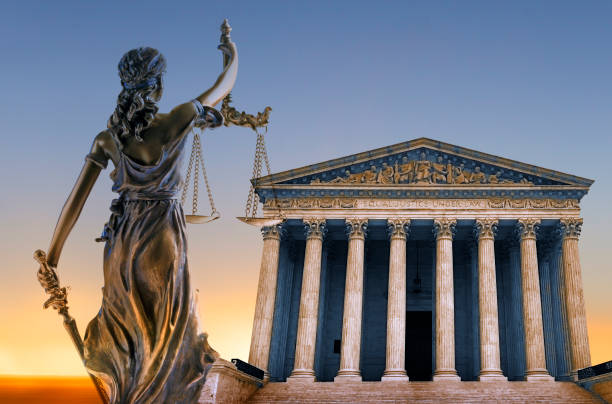
“I applaud the Court’s decision to invalidate the EPA’s power grab and rein in this lawless Biden Administration.” — Governor Greg Abbott
The Court Renders a Destructive Decision
In West Virginia v. EPA
Bill McKibben / The New Yorker
(July 1, 2022) — Credit where due: the Supreme Court’s 6–3 ruling in West Virginia v. EPA is the culmination of a five-decade effort to make sure that the federal government won’t threaten the business status quo.
Lewis Powell’s famous memo, written in 1971, before he joined the Supreme Court — between the enactment of a strong Clean Air Act and a strong Clean Water Act, each with huge popular support — called on “businessmen” to stand up to the tide of voices “from the college campus, the pulpit, the media, the intellectual and literary journals, the arts and sciences, and from politicians” calling for progressive change.
He outlined a plan for slowly rebuilding the power of industrial élites, almost all the elements of which were taken up by conservative movements over subsequent years: monitoring textbooks and TV stations, attacking left-wing faculty at universities, even building a publishing industry.
(“The news stands — at airports, drugstores, and elsewhere — are filled with paperback and pamphlets advocating everything from revolution to erotic free love. One finds almost no attractive, well-written paperbacks or pamphlets on ‘our side,’ ” Powell wrote, but he was able to imagine a day when the likes of Ann Coulter or Sean Hannity would reliably top the bestseller lists.)
Fatefully, he also wrote: “American business and the enterprise system have been affected as much by the courts as by the executive and legislative branches of government. Under our constitutional system, especially with an activist-minded Supreme Court, the judiciary may be the most important instrument for social, economic and political change.”
At the time he was writing, the “activist” court was standing up for things that most Americans wanted, such as clean air and water — and the right of women to control their own bodies.
But the Supreme Court, and hence the judiciary, has come under the control of the kind of men that Powell envisioned — he may not have envisioned women on the bench, but Amy Coney Barrett is otherwise his type of judge. And, with this ruling, they have taken more or less total control of Washington’s ability to generate policy that might disrupt the status quo.

In essence, the ruling begins to strip away the power of agencies such as the EPA to enforce policy: instead of allowing federal agencies to enforce, say, the Clean Air Act to clean the air, in this new dispensation, Congress would have to pass regulations that are much more explicit, as each new pollutant came to the fore.
As West Virginia’s attorney general explained, “What we’re looking to do is to make sure that the right people under our constitutional system make the correct decisions . . . these agencies, these federal agencies, don’t have the ability to act solely on their own without getting a clear statement from Congress. Delegation matters.”
But, of course, the Court has also insured that “getting a clear statement from Congress” to address our deepest problems is essentially impossible. The decision in Citizens United v. F.E.C., in 2010, empowered corporations to game our political system at will. That explains, in part, why Congress has not passed a real climate bill in decades.
The efforts that Democratic Administrations have made to try and control greenhouse gasses have mostly used provisions of the Clean Air Act because it is the last serious law of its kind that ever came to a President’s desk (Nixon’s, in this case).
A train of similar cases now approaches the high court — they would, for instance, make it all but impossible for the federal government to regulate tailpipe emissions or to consider the financial toll of climate change when deciding whether to approve a new pipeline.
As the Times reported in a recent investigation, the plaintiffs in these cases “are supported by the same network of conservative donors who helped former President Donald J. Trump place more than 200 federal judges, many now in position to rule on the climate cases in the coming year.”
And this new jurisprudence would, in turn, make it even harder to achieve any international progress on rising temperatures. If the United States — historically, the world’s largest emitter of carbon — can’t play a serious policy role, it won’t play a serious leadership role. John Kerry, Biden’s climate envoy, who has been trying to rally the world for more aggressive climate action, is running out of cards to play.
Given the record flooding in Asia, the record heat in the Mideast, the record fires in the Southwest, and the record rainfall in Yellowstone, there’s a nihilist strain to this ruling.
Be careful what you wish for: the biggest threat to corporate futures today is not a paperback about “erotic free love”; it’s an out-of-control climate that will undercut financial stability. But the conservative drive to roll back federal power has long since become more ideological than practical; the right-wing luminary Grover Norquist updated Powell’s plan for a feistier age, when he said that he wanted to shrink the federal government to a size that he could then “drown in a bathtub.” But drowning whole communities as the sea-level inexorably rises?

Can democracy stand up to a profit-biased court?
And what about the large majority of Americans who want action on climate change, and the activist campaigners who have pushed that desire to the fore? Those activists have engaged with good faith over many years in an effort to use the latent power of the federal government to make necessary change, but now that effort seems less and less sensible.
There remains an outside hope that the Build Back Better bill might still pick up fifty votes in the Senate before the fall, when Republicans could potentially regain control of Congress; the tax credits for renewable energy it contains would probably pass Supreme Court muster.
But beyond that it’s hard to see exactly what the point of demanding federal climate action is now; why march on the Capitol or the White House if the Supreme Court won’t let elected leaders act even if they want to?

And there’s no real way to march on the Supreme Court — it exists outside the ambit of normal politics — though rulings like this will also raise the pressure to expand the size of the Court, if and when the Democrats have the votes to do so.
You could also hope that an engaged Federal Reserve might take action — as Aaron Regunberg pointed out in a recent article, Court precedent (for whatever that’s still worth) might give the Fed some latitude. And state legislatures can act, too, though even there the Court may hem in their ability to, say, set mileage restrictions on cars — in fact, Republican attorneys general from around the country have already filed suit in the DC circuit court to do just that. (The DC circuit court contains new appointees such as Neomi Rao, who oversaw deregulation efforts in the Trump Administration before he offered her a seat on the bench.)
Campaigners will keep trying to win elections, and to write policy, but it took Lewis Powell fifty years to win this fight, and it may take fifty years to win it back — and we do not have that kind of time in the fight against warming.
Wall Street may be the only other actor large enough to actually shift the momentum of our climate system. The pressure on banks, asset managers, and insurance companies will increase precisely because the Court has wrenched shut this other spigot.
Convincing banks to stop funding Big Oil is probably not the most efficient way to tackle the climate crisis, but, in a country where democratic political options are effectively closed off, it may be the only path left.
Posted in accordance with Title 17, Section 107, US Code, for noncommercial, educational purposes.